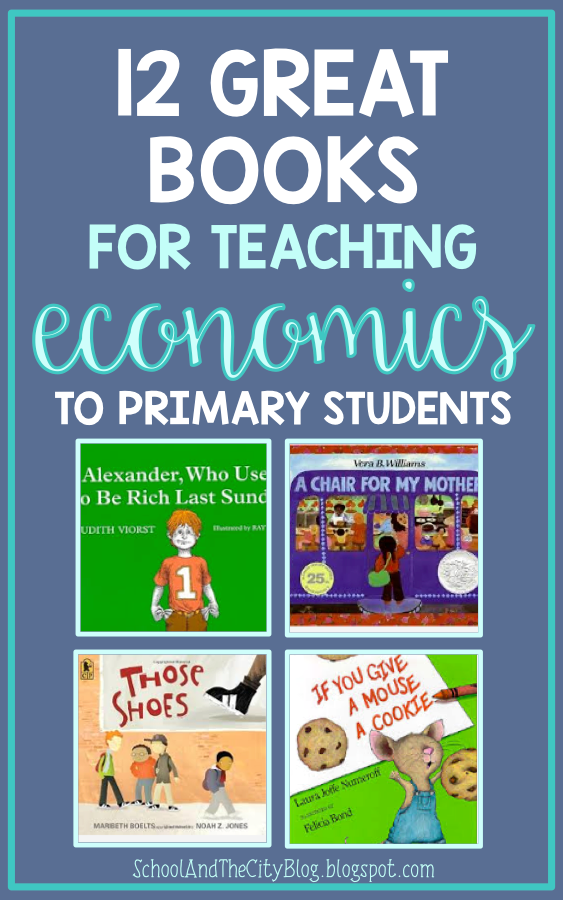
Oh, econ. It was the bane of my existence in college.
Fun fact: Econ was my second lowest grade in college. (My lowest grade was the class that I met my husband in… I guess I was a little distracted.)
So how in the world am I supposed to teach ECONOMICS to 7-year-olds?!
Actually, the first time I taught economics, it was to kindergartners. It was during my student teaching, and I had to create my own unit and materials.
When I started teaching second grade and realized I had to teach “financial literacy,” a prettier name for economics, I was much more confident. I took my kindergarten unit and expanded it to meet the academic needs of my second graders.
I will admit that second grade economics is much easier than my college course. Elementary school econ focuses on needs vs. wants, goods vs. services, producers and consumers, and saving and spending.
How do I make these concepts fun?
I use lots of songs, pictures, SCOOTs, great books, and many visual aids.
Take a peek! I think music is a great way to teach vocabulary, so each section of the unit has at least one song to go along with it, teaching vocabulary words and meanings.
I also use lots of real images and real life scenarios when teaching this unit. Students are more likely to comprehend when they can make a connection to real life.

All second graders love to SCOOT! I made a SCOOT for both needs and wants and goods and services. Students “scoot” around the room and determine whether each card shows a need or a want. Students record the answers on their SCOOT chart. (Answer key included!)

Each important vocabulary word in the unit has it’s own mini-poster to serve as a visual aid for your students. Sometimes I hang these words one at a time, and sometimes I put them all on an anchor chart. Each topic uses different colors so that students can easily see which words go together. This year, I plan to print these posters 4 to a page, laminate them, and put them on a binder ring for students to refer to during small groups, buddy time, or independent work.

I love using sorts with younger students. You can use a sort as a pre- and post-assessment or as a comprehension check mid-way through the unit. I usually do picture sorts as a class (using my document camera) soon after introducing the new topic. It’s the perfect opportunity for meaningful discussion. Then, I allow students to do the picture sort throughout the unit own their own or with partners.

I just LOVE the look of the real images, which help little learners make connections to real life.

The last topic is saving and spending. It’s my favorite! (Spending, I mean.) The section allows the opportunity to reinforce students’ knowledge of money and counting money. However, there are plenty of resources that do not require students to be able to count coins.

The culminating craftivity for saving and spending is a cute piggy bank. Students set a goal to save money for an item that they would like to buy. The following picture is from my kindergarten unit – sorry! – but I do make it more rigorous for my second graders. They choose something under $5 that they want to buy, they write that amount on the piggy bank, and they must show that exact amount using the coins. Social studies AND math – ta da!
Last but not least, also included in the unit is 10 days of lesson plans, quizzes for each section and a final assessment, and lists of resources for both teachers and students.

You can find my economics unit here.

2nd Grade Economics Read Alouds:
The following books are my favorite read-alouds for teaching wants / needs, goods / services, and saving / spending:

Those Shoes is about a boy who really wants the shoes that all of the cool kids at his school have. It is a great way to introduce needs and wants. There’s a read-aloud video of it on YouTube that I used to use before I bought a copy of the book for myself. Love it!

I like to use If You Give a Mouse a Cookie to practice identifying goods and services. We make a T-chart and categorize all of the things that the mouse asks for as either a good or a service. (This chart is part of the unit on TPT, or you can grab it for free here.)

Alexander, Who Used to Be Rich Last Sunday is my all-time favorite book to open discussion about saving and spending. It is hilarious to read about Alexander trying to keep up with his money! (I feel his pain!!)

Here is my complete list of books I’ve used to deepen my students’ understanding of 2nd grade economics standards:
A Chair for My Mother by Vera Williams
Alexander, Who Used to Be Rich Last Sunday by Judith Viorst
Arthur’s TV Trouble by Marc Brown
Berenestein Bears and Trouble with Money by Stan and Jan Berenstein
Chicken Sunday by Patricia Polacco
How Much Is that Doggie in the Window? by Iza Trapani
If You Give a Mouse a Cookie by Laura Numberoff
Just Shopping with Mom by Mercer Mayer
Max’s Dragon Shirt by Rosemary Wells
The Bag I’m Taking to Grandma’s by Shirley Neitze
The Giving Tree by Shel Silverstein
Those Shoes by Maribet Boelts
“Financial Literacy” (soooo fancy) AKA 2nd grade economics is the first social studies unit that we teach in second grade, so I will be starting to use these materials, for the fourth time, very soon!
Do you teach economics? If so, what are your favorite activities?
Have a question? Leave it in the comments!
**This post contains Amazon affiliate links. By purchasing an item from Amazon using these links, I will receive a small commission on your purchase.**